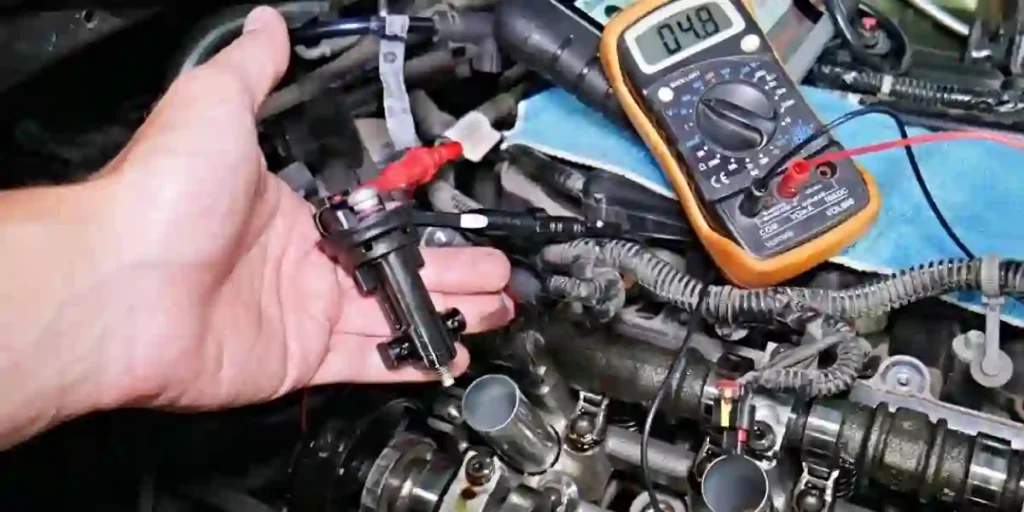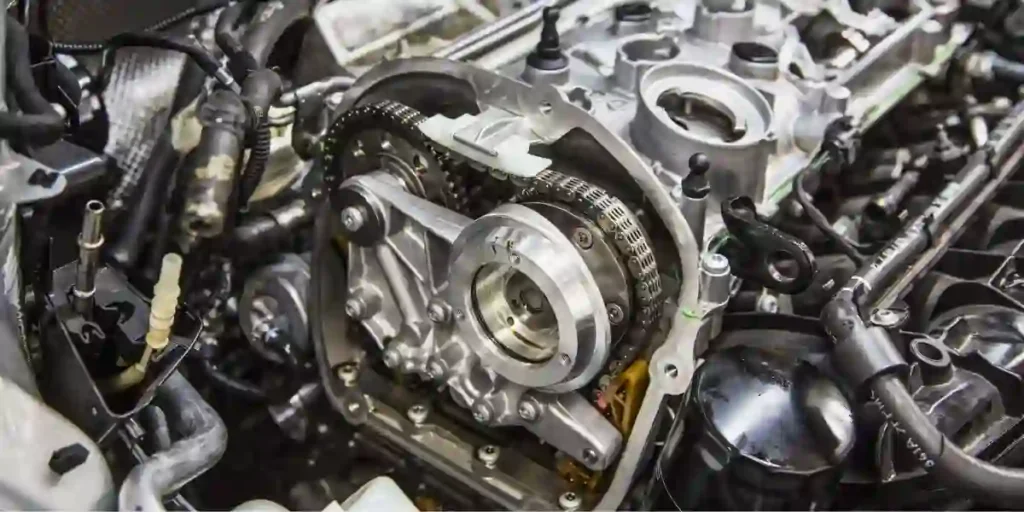Have you ever experienced a pesky Check Engine Light (CEL) that just won’t go away, despite replacing a faulty camshaft position sensor?
It can be frustrating to diagnose and fix a problem, only to have it come back with a vengeance. But fear not, because you’re not alone in this struggle. In fact, this issue is more common than you might think.
In this blog, we’ll dive into the nitty-gritty details of why your newly installed camshaft position sensor might still trigger an error code, and what you can do about it.

What does it mean replaced camshaft position sensor but still get code?
When a car’s camshaft position sensor gets replaced but the same error code still appears, it means that the problem hasn’t been completely fixed.
The camshaft position sensor is responsible for detecting the position of the camshaft and sending that information to the car’s computer.
If the sensor is faulty, it can cause a variety of issues, including poor engine performance, stalling, and difficulty starting.
Replacing the sensor is usually the first step in fixing the problem, but it’s possible that there’s another issue causing the same error code to appear.
For example, there could be an issue with the wiring or connector that connects the sensor to the computer. It’s also possible that the computer itself is faulty.
In any case, it’s important to have the car checked by a professional mechanic who can diagnose the problem and determine the best course of action to fix it.
Simply replacing parts without addressing the root cause of the problem can be a waste of time and money.
What to do if I replaced camshaft position sensor but still get the code?
If you’ve replaced your camshaft position sensor but are still getting the same error code, there are a few things you can do to troubleshoot the issue:
1. Double-check the installation:

Make sure that you installed the new camshaft position sensor correctly. Check the wiring harness and connectors to make sure they are properly connected and not damaged.
2. Check the wiring:
Inspect the wiring leading to and from the camshaft position sensor. Look for any signs of damage, such as frayed wires or corrosion.
If you find any issues, repair or replace the wiring as necessary.
3. Check the reluctor wheel:
The reluctor wheel is a toothed wheel that rotates along with the camshaft. If the wheel is damaged or missing teeth, it can cause issues with the camshaft position sensor. Inspect the reluctor wheel for any signs of damage or wear.
4. Check the timing:
If the camshaft position sensor is still not functioning properly, it’s possible that the timing is off.
Check the timing belt or chain to make sure it’s properly aligned and not stretched or worn.
5. Check other sensors:

If none of the above steps resolve the issue, it’s possible that there may be a problem with another sensor or component in the engine.
Have a professional mechanic perform a diagnostic test to identify any other potential issues.
Common Causes of Camshaft Position Sensor Codes
When you replace a camshaft position sensor but still get a code, there can be several reasons why this happens. Let me explain some of the most common ones:
1. Malfunctioning Sensor:
The replacement camshaft position sensor may be faulty or defective right out of the box, which can lead to the same error code popping up.
It’s essential to ensure that you’ve installed a high-quality sensor and that it’s the correct one for your vehicle.
2. Electrical Issues:
Another possible reason could be related to the electrical connections between the sensor and the engine control module.
Loose or corroded connections can cause the signal from the sensor to become distorted, resulting in a fault code.
Make sure to check the wiring, connectors, and fuse related to the camshaft position sensor.
3. Timing Belt or Chain Issues:

Sometimes, the error code indicating a faulty camshaft position sensor could be a result of the timing belt or chain problems.
The belt or chain could be stretched or have jumped teeth, causing the camshaft to spin out of sync with the crankshaft.
This can cause the engine control module to receive incorrect signals from the sensor.
4. Incorrect Installation:
It’s possible that the camshaft position sensor was not installed correctly. Improper installation can cause a misreading of the sensor and result in a fault code.
It’s crucial to follow the manufacturer’s instructions carefully when installing the sensor and double-check the installation.
5. Engine Control Module Issues:
Finally, there is a possibility that the engine control module itself may have some issues.
A malfunctioning engine control module could incorrectly diagnose a camshaft position sensor as faulty and show the corresponding code.
If you’ve ruled out all other causes and the problem persists, you may need to get the engine control module checked by a professional mechanic.
How to Replace the Camshaft Position Sensor?
Replacing a camshaft position sensor can seem daunting, but it’s actually a relatively simple process that you can do yourself with the right tools and a little bit of know-how.
Here are the steps you should follow:
1. Locate the sensor:
The first step is to locate the camshaft position sensor in your vehicle. The exact location can vary depending on the make and model of your car, so consult your owner’s manual or a repair manual for guidance.
In most cases, the sensor will be located near the top of the engine, near the camshaft.
2. Disconnect the battery:

Before you start working on the sensor, it’s important to disconnect the battery to avoid any electrical shocks.
Use a wrench to loosen the negative cable and remove it from the battery.
3. Remove any components in the way:
Depending on the location of the sensor, you may need to remove other components to gain access to it.
This could include things like the air intake or engine cover. Again, consult your owner’s manual or repair manual for guidance.
4. Disconnect the electrical connector:
Once you have access to the sensor, use a flathead screwdriver or pliers to gently remove the electrical connector that connects the sensor to the wiring harness.
5. Remove the sensor:

Next, use a socket wrench or pliers to remove the bolts or screws that hold the sensor in place. Be careful not to drop any bolts or screws into the engine bay.
6. Install the new sensor:
Once the old sensor is removed, carefully install the new sensor in its place. Make sure it’s properly aligned and tightened down with the bolts or screws.
7. Reconnect the electrical connector:
Finally, reconnect the electrical connector to the new sensor and make sure it’s securely in place.
8. Reassemble any components:

If you had to remove any components to access the sensor, now is the time to put them back in place.
9. Reconnect the battery:
Finally, reattach the negative cable to the battery and tighten it down with a wrench.
FAQs
Q: I Replaced My Camshaft Position Sensor, But My Check Engine Light Is Still On. What’s Going On?
A: If you’re still getting an error code after replacing your camshaft position sensor, there could be a few different things going on. First, make sure that you’ve replaced the sensor with the correct part for your vehicle. Double-check the part number and make sure it’s compatible with your make and model.
Q: What Else Could Be Causing The Error Code After Replacing The Camshaft Position Sensor?
A: It’s possible that the issue isn’t with the sensor itself, but with the wiring or connections that lead to the sensor. Check for any frayed wires or loose connections and repair them as necessary. Additionally, there may be other issues with your vehicle’s engine that are causing the error code.
Q: How Can I Diagnose The Problem If I’m Still Getting An Error Code?
A: If you’ve checked the sensor and its connections and are still getting an error code, it’s a good idea to take your vehicle to a mechanic for further diagnosis. They’ll have the tools and expertise to pinpoint the issue and recommend the best course of action.
Q: Can I Drive My Vehicle If I’m Still Getting An Error Code After Replacing The Camshaft Position Sensor?
A: It’s generally not recommended to drive your vehicle if you’re still getting an error code, as this could indicate a serious problem with your engine. It’s best to have the issue diagnosed and repaired as soon as possible to avoid any further damage to your vehicle.
Conclusion
Even after replacing the camshaft position sensor, it’s possible to still get a code indicating a problem with the sensor.
This may be due to a few reasons, such as an electrical issue, a faulty connection, or a problem with the engine’s timing.
It’s important to diagnose the issue correctly and thoroughly before assuming that the sensor itself is defective.
If you’re experiencing issues with your camshaft position sensor, it’s best to consult a mechanic or a qualified technician who can help you pinpoint the root cause of the problem and recommend the appropriate solution.
